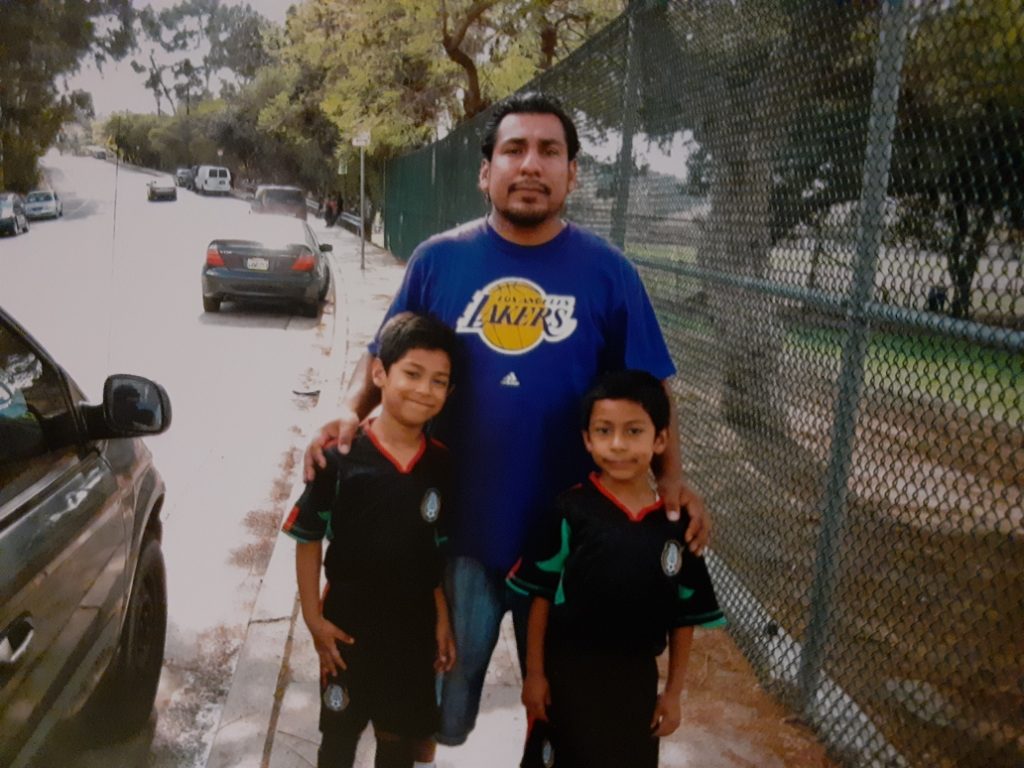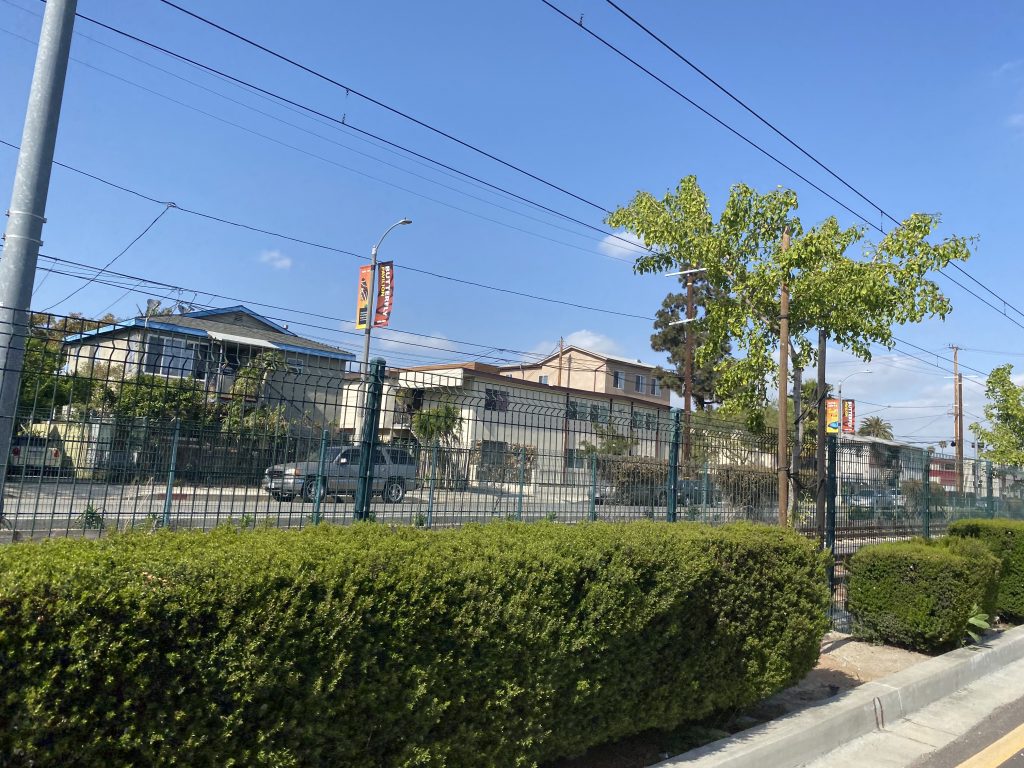For Virgilio Calzada, 37, things began to get difficult just as the pandemic hit the U.S. with full force. He managed to pay rent in February, but in March his job as a soccer coach through the American Union Soccer League ended abruptly and he was left with no options, he said.
“I applied so many places,” Calzada said. “I reached out even to the councilman of my city to please help me with whatever you can, I don’t want to lose my things.”
Things got so bad, Calzada and his two teenage sons were threatened with eviction from their South Los Angeles apartment. Thanks to help from a public defender acquired through the Los Angeles Tenants Union and temporary protections put in place by the county because of the pandemic, though, Calzada was able to stay in his home during the last year.
“I got the extension until the 30th because he wanted to take over my property, my belongings,” he said. “It’s just been terrible you know.”

Any sense of security Calzada had may soon come to an end. The moratorium on evictions is likely to be lifted in June as conditions in L.A. County continue to improve, COVID-19 restrictions are lifted and people return to the streets, shops and restaurants. That means non-payment evictions may once again resume and Calzada could be forced out. That scares this father of two.
“Man it’s hard, you know,” he said. “We try and suck it up and portray this tough guy when in reality sometimes we’re weak, man.”
Calzada’s case is just one example of the lasting financial impact that for many indicates the pandemic is far from over. In South L.A., according to Census data, more than half of households are renters, and local advocacy groups say they were already facing insecurity due to long-standing issues that took root before the pandemic.
Despite the eviction moratorium, and aid in the form of stimulus checks and rental assistance, activists say tenants across the area have faced illegal lockouts and harassment from landlords. Residents also have faced new obstacles as they’ve tried to navigate new forms of technology for the first time and deal with issues of status and unstable living situations in the pandemic.
“We’ve spent a lot of effort and time giving people the ability to be able to connect remotely to meetings,” said Paul Lanctot, an organizer with the L.A. Tenants Union. “We’ve been cognizant of certain times where there have been surges, but we’ve also still been forced to try to meet outside at tenants’ apartments, meet with tenants in a socially distance manner with masks to try to inform them of their rights and to talk about the next steps.”
Now, they live in a kind of limbo, waiting to see how the good news surrounding the fight against the virus could be bad news for their futures. With safeguards like the moratorium still in place, groups such as the L.A. Tenants Union and the Community Coalition, say that limbo is a critical moment for action because once those temporary programs and protections are rolled back and the county returns to a sense of normalcy, that’s when people will begin to truly see the impact of the pandemic.
“Landlords will be in their legal right to be get away with evicting the people,” said Oscar Alvarez, an organizer with the Community Coalition. “It’s not waiting to ‘if,’ it’s waiting to ‘when.’”
To try and head off an eviction crisis, California is running a rent relief program (aided by federal funding) that will pay a portion of the back rent owed by qualifying applicants if landlords agree to forgive the remaining amount.
Jumping through hoops
At a training held on Zoom by the L.A. Tenants Union and South Central Mutual Aid two days before the City of LA’s rent relief deadline of April 30, tenants peppered caseworkers with question after question. Some entered late and others entered and exited the video call every few minutes because of technological trouble, but over the hour and a half, attendees voiced some concerns and shared others through the chat, nervously explaining their situations and requesting second pass throughs on slides in the initial presentation. Most of the applicants on the Zoom were identified by just their first names.
Zenaida, for example, is two months behind on her rent because selling sweets has been hard during the pandemic and she was confused about the document requirements.
“I want to apply so that they help me pay the rent,” she explained in Spanish after entering the meeting toward the end with help from another attendee. “What papers are they going to ask me for? Because the man has been asking me for the rent.”

Eugenio, on the other hand, was worried his household income might be too high even though his wife and his housemate both had to stop working toward the beginning of the pandemic because their use of public transportation worried their employer. If they still made too much, however, that could lower their chances of receiving aid.
“I’m asking because I was looking at the amount that a person has to have,” he said in Spanish. “But I think I surpass what they ask.”
Saul was worried about a few nearby tenants he’s helped that struggle with technology and may not have access to email, asking what the probability would be of an extension, to which Adriana Cabrera, with South Central Mutual Aid, recommended that everyone voice such issues to their council members and take advantage of the individualized workshop the organizations were offering in person on the last day.
“It’s been really challenging to help the families with these issues of the technology,” he said. “I’m afraid that some of them are going to lose out.”
Others at this event were concerned about proving their incomes because they were paid in cash or about what to do if they lived in a unit not officially set up as a rental. There were also questions about how to deal with miscommunications with a landlord.
“Many of them are a paycheck away or are literally being protected by the rent moratorium that’s happening, so they’re a few months away from being evicted,” Cabrera said at the training. “We’re trying our best to be a support in creating this space.”
Tenants were also encouraged to work together and spread the word about their rights and existing relief programs. Nico Dregni of the L.A. Tenants Union said it’s more important than ever for community members to have one another’s backs and build connections.
“We need to make sure that what we’re building goes beyond what is offered by the government and is about the solidarity that we have with one another, so that we can protect each other,” Dregni told the two dozen attendees at the rent relief training.
COMMUNITY ORGANIZERS SHARE OBSTACLES



“Equity means that the folks that are the most vulnerable, get the money first.”
Rudy Espinoza, Inclusive Action for the City
(Photos courtesy of Paul Lanctot, Rudy Espinoza and Oscar Alvarez)
Currently, the moratorium has allowed those financially impacted by COVID-19 to avoid eviction as long as a quarter of back rent owed between September 2020 and June 2021 is paid by the end of June under state guidelines. Tenants have until August to pay past due rent accumulated between March and September 2020 per L.A. County’s moratorium.
Under California’s rent relief programs, tenants who qualify will get 80 percent of their back rent covered if landlords agree to forgive the remaining 20 percent. The county application will remain open until funds run out. The program launched in mid-March with federal and state funds and has allocated more than $353.9 million to L.A. County and $261.6 million to the City of LA, according to data from the California Department of Housing and Development. Those whose landlords do not agree to participate may apply for funds that cover the quarter of owed rent that must be paid by June 30 to avoid eviction.
“What we’ve seen is that those programs haven’t really supported tenants all that much,” Lanctot said in an interview. “The thing that has somewhat — when tenants are able to assert their rights — is the increased protections against eviction.”
Though advocacy groups have pushed residents to apply for the program, there is concern among groups such as the L.A. Tenants Union and South Central Mutual Aid around landlord buy-in to the program and overall accessibility. Though the state has received support from several landlord associations, including The California Apartment Association, Russ Heimerich, who works in communications at the California Business, Consumer Services and Housing Agency, said it’s difficult to know the opinions and intentions of individual landlords.
“We have sort of a window into the larger landlords because there are associations that represent them,” Heimerich said. “Mom and pop may have a handful of residential properties that they rent out. We don’t have a way of communicating with them through an association.”
Nonetheless, Lanctot said that even if residents don’t receive the funds, it’s proof of good faith if threatened with eviction later.
“If you’ve don’t get accepted, this can also be used as proof to show that you’ve done everything in your power to try to get the landlord back rent and you can use that as a negotiating leverage,” Lanctot told the attendees at the training. “We can support you in using that as negotiating leverage to pressure the landlord to forgive you rent outside of this process.”
This program follows programs from the City of LA and L.A. County, most recent of which closed in July and August respectively but provided assistance to eligible tenants based on zip code and income. More money is expected to be pushed toward rent relief under President Joe Biden’s new American Rescue Plan, signed in March, but what that distribution will look like is not yet known.
Dealing with instability
Even with protections and support in place over the past year, navigating the pandemic has not necessarily been easy for many, including Virgilio Calzada. He said he has dealt with harassment from his landlord, who appeared frustrated with his inability to evict Calzda. At one point, Calzada said, his landlord blocked his driveway and swore at him, forcing Calzada to call the police.
“I get it, this is not my property — I know it’s not — but he needs to understand this COVID stuff. It’s not like I intentionally stopped wanting to pay it,” Calzada said.
Many local organizations said they have noticed harassment and illegal evictions occur more frequently during the pandemic. Since March 2020, members of the L.A. Tenants Union have shown up in support of tenants across South L.A. as they’ve dealt with similar problems. Members supported a tenant whose toilet was removed, belongings thrown out and electricity turned off in May 2020. They, along with members of Alliance of Californians for Community Empowerment, marched in support of an elderly stroke victim and her son who were illegally evicted from their home in Vermont Square in October. On multiple occasions, the organization has protested on behalf of tenants whose belongings were removed and the locks on their homes were changed.
“Landlords have been threatening tenants with their documentation status, and some of them have been threatening to just bring crews of people and they have done it just to throw their things out onto the street when they don’t pay rent, which we call an illegal lockout,” the L.A. Tenants Union’s Lanctot said. “It’s an illegal eviction that doesn’t actually go through any sort of court proceedings.”
Data from the Los Angeles Police Department acquired by the Los Angeles Times showed that landlord-tenant disputes rose by nearly a fifth in the first three months of the eviction moratorium. The majority of incidents that involved police were in South L.A. neighborhoods, including Vermont Square where Calzada lives. L.A. County’s Department of Business and Consumer Affairs also said it has received about 50,000 calls regarding issues between tenants and landlords since March 2020.
“We respond to landlord disputes to keep the peace,” LAPD Officer Rosario Cervantes wrote in an email. “It’s more of a civil matter.”
Jonathan Pacheco Bell, a freelance urban planner who has worked in L.A. for 15 years, said the data points to an issue that isn’t new in South L.A. neighborhoods. Economic forces were displacing residents and creating tense situations long before anyone ever heard the word “COVID-19.”
“You started to see it before the pandemic, that kind of creeping gentrification and with that instability,” he said. “And then the pandemic hits and it completely destabilizes the economy and the work environment. There were a lot of frontline workers who lost their jobs. They couldn’t work from home — that was not an option — so you saw layoffs and people unable, therefore, to pay their rent, pay their bills, further destabilizing the rental market that has already started to see signs of gentrification,” Pacheco Bell said.
EXPERTS TALK GENTRIFICATION

planner

(Photos courtesy of Jonathan Pacheco Bell and Bruce Mitchell)
Bruce Mitchell, a senior research analyst at the National Community Reinvestment Coalition, said that is also a national trend that has accelerated with the pandemic. Before COVID-19 hit, Los Angeles placed second among metro areas from across the U.S. that showed signs of gentrification, according to his research on gentrification and disinvestment between 2012 and 2017.
“The real problem with gentrification is that it oftentimes drives out the existing population that can no longer afford to live there,” Mitchell said. “They don’t get the benefit of perhaps seeing a food desert disappear; they don’t get the benefit of seeing the quality of the schools increase; they don’t get the benefit of seeing the city investments and infrastructure within their community. They end up having to leave because it’s no longer affordable to them.”
Even before the pandemic and his current financial hardships, Calzada knew his days at his South L.A. apartment were numbered. He said his landlord had complained to him that he could easily rent the apartment for $2,000 a month as opposed to the $1,300 Calzada paid. Two months before the shutdown, Calzada said he watched his downstairs neighbor get evicted.
“I knew that I was gonna be next because he saw that I was having trouble,” he said.
Though Calzada isn’t quite sure what he will do once the moratorium ends, he is keeping the faith that, with support and his neighbors on his side, he will make it work, he said.
“I’m very grateful that I’m still alive and my kids, and we’re staying hopeful,” he said. “We’ll see the light at the end of the tunnel. I’m a fighter and I know I am gonna get up from this hole that I am at.”
